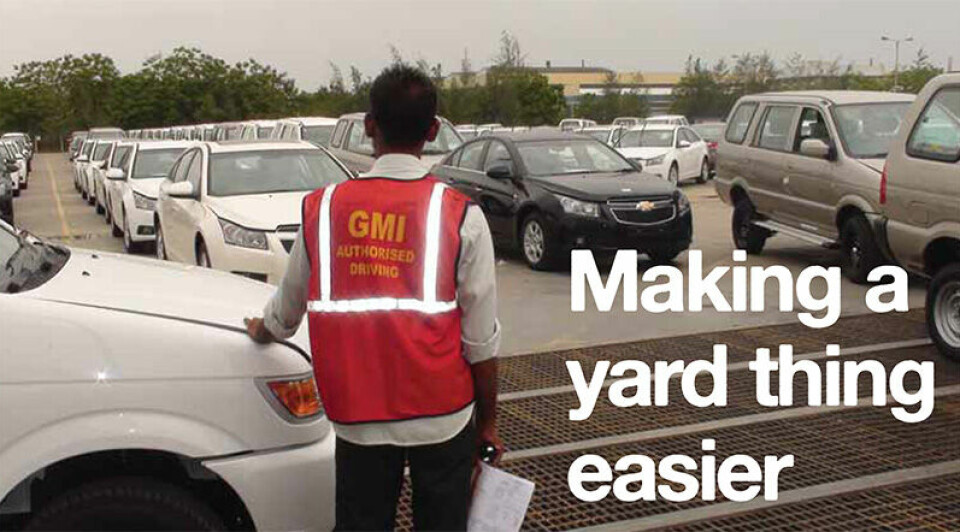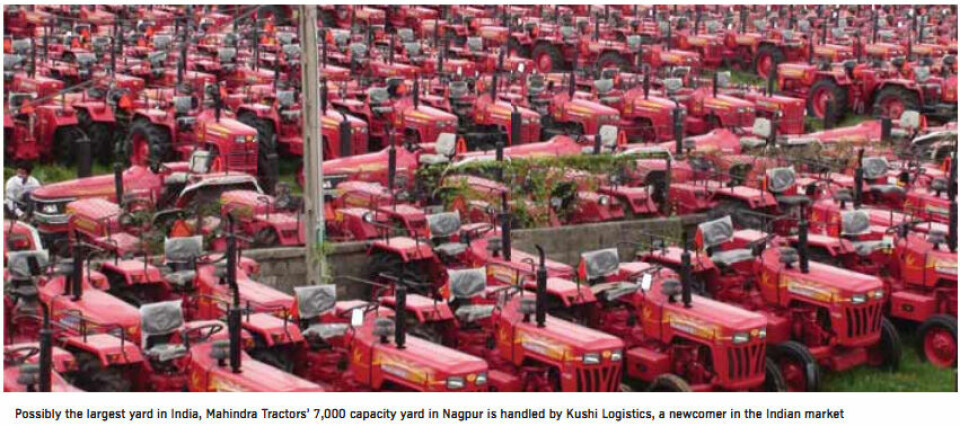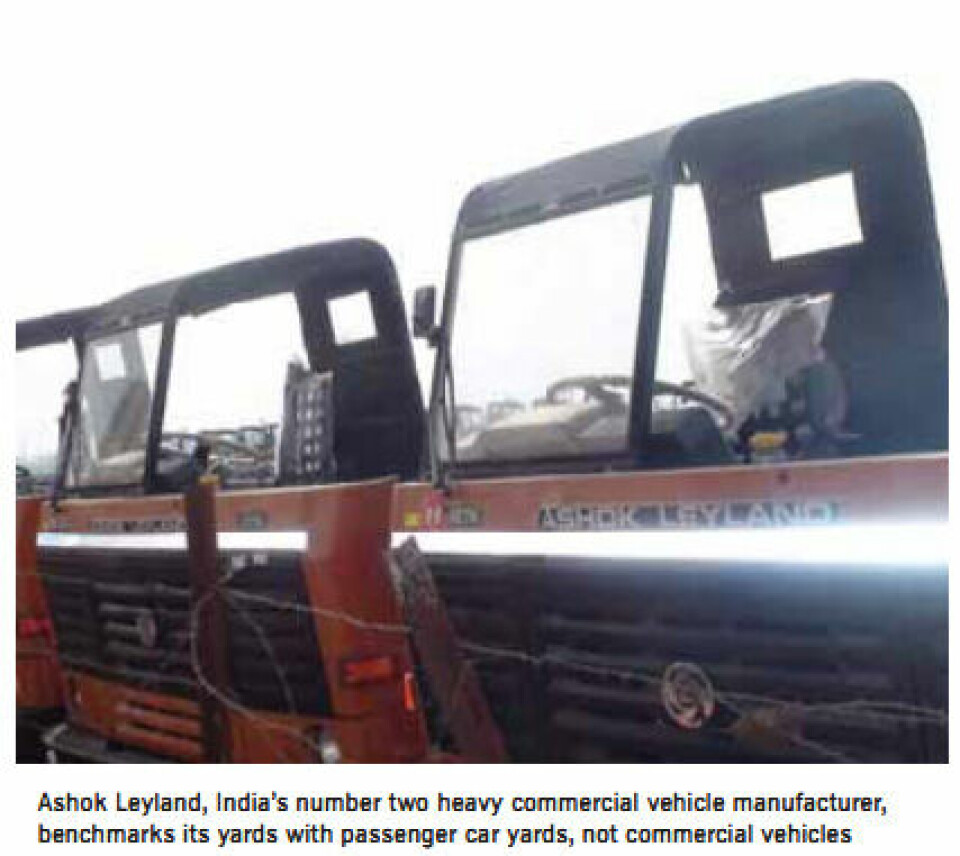Making a yard thing easier

The growing appreciation of yard management systems in India and the equally expanding possibilities for 3PLs.
Tarun Sarkar kneels down on the wet ground and runs his fingers along the bottom of a red Chevrolet Beat. He fixes his eyes on something under the car that nobody else seems to see. Half a dozen employees of third-party logistics provider TVS Sundharams stand pensively watching him. “Ah, it’s fine. Good,” Sarkar says as he raises his body and dusts off his arms and palms. A dark patch has formed on the knee of his trousers from the overnight rain which earlier drenched the spacious stockyard for General Motors vehicles in the southern city of Kochi, several thousand kilometres from GM’s plant at Halol, Gujarat.
Sarkar crosschecks an entry in a logbook about a repaired dent under the Chevrolet Beat. Among the anxious crowd is M Ganesan, vice-president of TVS Sundharams, which has a contract to manage the stockyard for GM.
The visit is part of a bi-monthly yard audit at GM. Sarkar is responsible for all of the carmaker’s yards in India, including Kochi and Bangaluru in the south, Guwahati in the northeast and the in-plant yard at Halol. Sarkar examines documentation, questions the staff about activities – or ‘drills’ – and processes at the yard. All damage and repairs are logged, claims recorded, and methods verified and approved. The goal is to create an external yard with the same efficiency and quality expectations as the plant itself, so that every vehicle dispatched from here to dealerships remains ‘factory fresh’.
Such rigour in processes is now common for many global carmakers in India, with sophisticated yard management slowly gaining traction in the country. Although the yards themselves might not have the scale and the amenities of their Western equivalents, such as often lacking paved surfaces, having less advanced IT for tracking and monitoring vehicles and lower levels of security, carmakers and providers are doing more to raise India’s stockyards to global standards. And with coming changes to the marketplace, including a long-touted plan to centralise certain taxes that would enable cross-state stock holding, the pace of development for yard management in the country looks set to quicken.
The birth of yard management in India
Yard management is still a relatively new concept in India. Rewind 25 years to when the Indian passenger car market was dominated by Hindustan Motors’ Ambassador and the Padmini from the Fiat-linked Premier Automobile, and most cars were typically moved on their own wheels from assembly lines to dealerships, even if it meant driving them thousands of kilometres.
With a huge gap between demand and supply, customers faced waiting periods of six months. Carmakers ran assembly lines only when their order books were full and money was received. Vehicles out of the factory were rarely parked at the plant prior to dispatch, let alone given pre-delivery inspections (PDI). “Where was the need to stock and send?” asks Bhuvan Nanda, who was then a teenager fresh out of school and helping his uncle Anil Nanda in Ahmedabad to manage Fiat’s sales. Now chief executive officer at GTC Logistics, he recalls
that neither OEMs nor customers paid much attention to potential damages in transport or handling: “[Customers] would grab the ignition key and run away with the car. Nobody bothered [about damage]. All that mattered was the ultimate possession of the car,” he remembers.
When it became necessary to store newly built vehicles for a day or two before delivery, plant teams would invariably find an open space within the factory premises or even outside. According to Vinay Deshpande, a supply chain manager at Fiat Automobiles India, an old hand from the Padmini days, “It was not unnatural for cars to be parked even in our company colony roads.”
The advent of Maruti Suzuki in the mid-1980s, which brought Japanese best practices and the concept of ‘factory fresh’ vehicles to India, changed yard management in the country. Fiat’s Deshpande recalls being impressed by the sight of Maruti yards in Vapi, Gujarat holding 1,000 or more vehicles.
Indeed, foreign collaboration inevitably led to the awareness of yard management practices among Indian OEMs. “We’re privileged to learn from the best masters,” says Achil Paliwal, who spent more than a decade at Maruti Suzuki before joining Honda Siel Cars, where he is head of logistics and exports.
Sukanta Pandit, location head at Mahindra Logistics, responsible for logistical operations at the Mahindra plant at Nashik (200km from Pune), reveals that the provider learnt its own yard practices from former partner, Renault. “Our learning comes from Renault, but it was not easy changing the Indian mindset, which is steeped in the ‘park for delivery’ format.”
For carmakers that haven’t had local partners, best practice has been imported from other regions. GM has a global format for yard management that it applies to all local conditions, according to GM India’s vice-president of global purchasing and supply chain, Ashwini Muppassani.
The result is that OEMs in India today have come to appreciate the value of vehicle yards, whether in-plant, at ports or inland. Paliwal explains that good yard practices help maintain healthy inventory management and a good brand image. “How you manage your inventory and your stockyard helps to build a robust brand image, which helps you to sell more.”
Learning the value add of yard management
While yard management is more common now in India, some OEMs still do not see it as specialised enough to outsource to 3PLs. “Several OEMs are managing the plant yards in-house and don’t intend to outsource. They don’t see value addition from 3PLs managing the yards,” confirms Captain Sandeep Chawla, director of NYK Auto Logistics India.
According to WWL country head Captain Gur-Prasad Kohli, OEMs do not always understand the added value that yard management specialists might offer, including loading optimisation, traceability, damage reduction, PDI (which drives quality improvement in production) and accessory installation. “3PLs are not labour providers to drive your car from the assembly plant to any open space until they are carted out. Our value addition is phenomenal,” he says.
But Kohli acknowledges that, at least among WWL’s customers, there is still something of a divide in India between carmakers willing to invest more in improving yard management and those who aren’t. While globally, WWL serves OEMs such as Nissan, Ford, GM, Toyota, BMW, Mercedes-Benz and Honda in regions across North America, Thailand and Australia, in India WWL has not gone beyond Nissan and Caterpillar.
Land, labour and lost visibility
The biggest challenge for yard management in India is investment in real estate. While an expanding market might prompt OEMs to look for external yards, in a stagnant or declining market, such as India has experienced for much of this year, most look to make use of existing, unused space. For example, Maruti Suzuki has recently set up a 90,000-vehiclecapacity yard in Nagpur on land that it has owned for many years. Most often, carmakers lease land on a relatively short basis, which could put more pressure on 3PLs to operate with relatively short guarantees. “Convincing the top management to invest in yards is a challenge,” admits Honda Siel’s Paliwal.
Manpower or skill development is another big concern for OEMs and 3PLs. According to NYK’s Chawla, the market suffers from a shortage of skilled staff and high turnover. Fiat’s Deshpande warns that part of the problem is OEMs don’t pay enough attention to the training and skill level necessary to work in yards. “Don’t underestimate yard management as a low key affair. It is very complicated and labour intensive,” he says.
Except for a small management team, 3PLs and OEMs tend to use contract labour for drivers and handlers. As well as the necessary licence, these drivers need to be specially trained to meet OEMs’ specifications for driving in yards, which include strict speed limits and handling processes.
However, since 3PLs and OEMs have no direct control over them, drivers often change jobs. “The sense of ownership and responsibility and execution is several notches higher when the labour force at yards is on your own payroll, rather than contracted,” says WWL’s Kohli.
Another difficulty for yard management in India is the fairly low level of IT penetration. “IT is limited. Several OEMs don’t intend to invest for the visibility in the yard,” says NYK’s Chawla.
With the lack of an effective inventory management and location system, it is common for large teams to rush into the in-plant yard just to find a single elusive vehicle, without which a car carrier might not be able to move from the factory gate. Barcodes, though used, do not always provide enough real-time information. RFID, which could be more effective, is often deemed too expensive and inappropriate for yards in India.
Some companies, such as Honda Siel’s homegrown Honda Logistics Management System, are moving further in the direction of improving efficiency, but there is still a long way to go.

According to Jasjit Sethi, chief executive officer of TCI Supply Chain Solutions (TCI SCS), yard management and its outsourcing are still in their infancy in India and margins are low. His assessment is accepted by Rajan Prahalad Agarwal, director of the newly floated Kushi Logistics, which deals in yard management. “There is a limit on what you can demand from OEMs for parking their vehicles in your yard. A successful business model insists on value addition at the yard.”
Mahindra Tractors’ 7,000 capacity yard in Nagpur, possibly the largest yard in India, is handled by Kushi Logistics, where Agarwal points to a range of value-added services on offer.
Cost-conscious Indian carmakers befuddled WWL’s Gur-Prasad Kohli when the company started offering yard management in the country. “We realised that this rate offer discussion is unlikely to take us anywhere. We have since changed tack and are offering to study [an OEM’s] current yard management operations for 2-3 days for a gap analysis and then offer a solution,” he says. “The idea is to tell them how we can help improve the bottom line through better operational efficiency at a fair cost,” he says, adding that the company is started to see more interest as a result.
Japan’s NYK is no stranger to Indian OEMs as it has been handling yard management for Maruti Suzuki at the ports of Mundhra and Mumbai, as well as for Mahindra & Mahindra in Mumbai. It is also handling yards for foreign carmakers including Volkswagen, Ford and BMW and is currently bidding for Maruti Suzuki’s transit vehicle park at Nagpur.
Most of the larger yard management players are from overseas, but Indian domestic players are on the march. TCI SCS is already a major player, while TVS Sundharams and BLG Parekh (a joint venture from the German-based provider) are newer domestic players who see opportunities in the segment.
Mahindra Logistics, part of the Mahindra & Mahindra group, also wants to enter yard management as a niche area.
Despite the market’s current chill, the future of yard management in India looks bright. Consumers demand cars quickly and in perfect condition. Meeting these requirements means selling out of a certain stock level, a practice already common in India. “Manufacturing without waiting for orders is happening,” affirms Mahindra Logistics’ Pandit.
Yard management is also likely to change considerably once the Goods and Service Tax (GST) is phased in. This centralised tax, which will eliminate duties required for crossing state borders in India, will pave the way for larger regional hubs serving multiple states. Maruti Suzuki’s existing stockyard at Bangaluru and the yet-to-be unveiled Nagpur facility both point in this direction. Mercurio Pallia Logistics’ managing director, Vipul Nanda, who is bidding for the Nagpur yard along with NYK, confirms this coming change. “GST will change the market dynamics,” he says.
Hyundai, for instance, has discussed plans for sometime within its corporate corridors for a yard in Siligiri to serve the northeast. GM’s Guwahati yard, meanwhile, has impressed many OEMs with its high security and quality. The upside, notwithstanding the current weak market, seems encouraging.
The potential for growth of rail for moving vehicles could usher in more developments in yard management. While rail movement is still the exception in India, General Motors recently began using the mode to move vehicles from Pune to Kolkota/Guwahati to feed the northeast, cutting leads times from three weeks to less than one. WWL’s Kohli sees rail fostering multi-user yards, for example. Indeed, at least one international joint venture is being finalised to work in the rail and yard management segment.
But will OEMs that currently refuse to share car carriers and warehouses really go for a multi-user yard format?

“Wait and watch. Things are changing,” remarks Shailesh Hazela, director of global supply chain at General Motors India. “We are still looking at everything through the road movement prism. OEMs are sharing rail rakes for long haul [transport] without hesitation. The same will happen in yard management.”
Steve Jones of Vehnet, a British software vendor eyeing Indian OEMs for its special yard management software, including a cloud-based solution, believes that India has a chance to leapfrog many of the inefficiences present in the North American or European yards.
“Do not think Europe or the US is always at the leading edge. Far from it…I visit many yards, and too many are below an acceptable standard.”
According to Jones, yards are a vital but overlooked link in the supply chain. “In the end, costs are driving everything. But a well-organised yard, even with low-cost labour, will still outperform a badly organised one. Higher standards are needed. Those who ‘see the light’ will win out compared to unprofessional competitors.”
Inadequate IT support, a lack of skilled manpower and cost-conscious OEMs are the reality of today’s Indian yard management. But the industry is showing signs of a change in mindset, with a focus on quality delivery (for both Indian and export consumers), changes to the tax regime and a growth likely to bring in more advanced yard management practices. Even at commercial vehicle manufacturers, there are signs that yard management is gaining more focus. Chandrakant Mishra, head of logistics at Ashok Leyland, India’s number two heavy commercial vehicle manufacturer, says that his top management has asked him to benchmark yards with those for passenger car yards, not commercial vehicles.
A recent group created on LinkedIn, the business social networking site, is also hoping to put more emphasis on the benefits of improving yard management in India. Initiatives such as these are important given the skills shortage and lack of investment in some areas. Currently, not every OEM will look to pay more for top-notch yard management services. Global logistics providers and yard management specialists in particular will have to push hard to educate OEMs in India of their added value.





